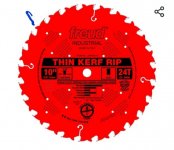Whole books can be written on tablesaw blade selection, as there are many factors operating together and what's important to you may be different than what's important to other people. Here are some of my thoughts:
• The primary reason why "rip blades" have fewer teeth is to enable faster feed rates.
• The way those "kickback shoulders" work is to prevent you from feeding the workpiece too quickly. Literally, as the shoulder doesn't cut wood so you just can't push it too far before the shoulder gets in there and stops your feed until the next tooth comes over and cuts a bit of wood away.
• Burning is caused by teeth rubbing against previously cut wood. There are several potential causes of this, from misaligned saws to dirty blades to blades with wobble to not being to keep the wood tight against the rip fence to the wood itself releasing stresses that cause the wood to change shape as you cut it. Feeding too slowly aggravates the problem, but is not the primary cause and usually requires something else to be at play.
• The "ole standby" for 10" tablesaws is the Forrest 40T Woodworking II blade:
https://www.forrestblades.com/woodworker-ii-all-purpose-saw-blade-for-table-saws/ They say to choose the 30Tooth version if you're mostly cutting 2" or thicker woods.
If you're getting burning, there are several steps you can take to diagnose the problem. Here are some:
• First, just try raising the blade so that it sticks up more than ½" above your workpiece. Yeah, I know the standard advice is to keep the saw blade just ⅛" above the workpiece, but that's for safety reasons only. If you're using a splitter and guard and push sticks, that low a blade keeps too many teeth in the cut kerf for too long and if everything isn't perfect can lead to burning. Raising the blade so that at the top the full tooth is above the workpiece helps a lot with burning (teeth don't spend as long in the kerf) and also means easier feeding.
• Second, are you using featherboards and a splitter? Featherboards keep the stock against the rip fence so it doesn't move a tiny bit away, causing the back teeth to rub and burn. A splitter can help with that, too, if it's thick enough.
• Third, if you're still getting burning, try to watch the stock get burned as you're feeding it. This requires a clear guard (or no guard, which can be dangerous). But, see if the stock is burning from the "back teeth" or not. Back teeth refers to the teeth coming UP from the table that should be riding inside the previously cut kerf and not doing any cutting. But, they can rub in that kerf and cause burning. If this is happening, they you may have a mis-aligned rip fence. If you're getting burning at the top of the stock, then you didn't raise the blade enough (and may still have alignment or saw blade quality issues).
• Fourth, as mentioned above, check the alignment of your rip fence. Maybe even have the rip fence at the rear of the saw be slightly away from the blade just to be sure.
• Finally, it is possible, but not necessarily likely, that changing the blade will solve your burning problems by itself.
Anyway, get a good 40 tooth ATB blade and if you get burning with that, then look elsewhere for your burning solution.


